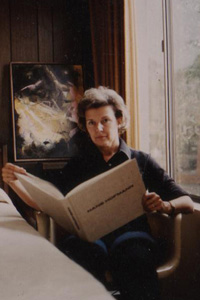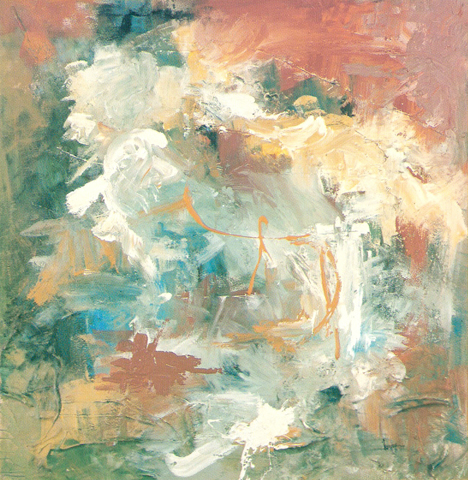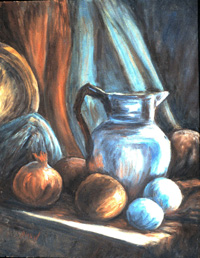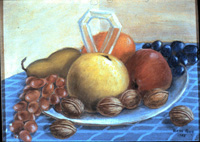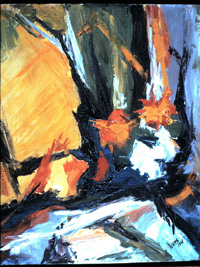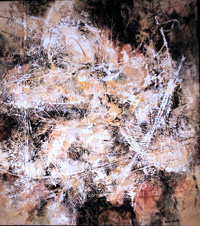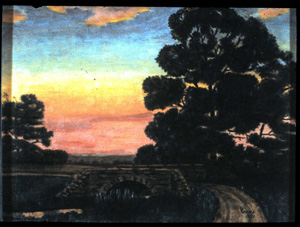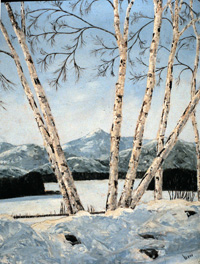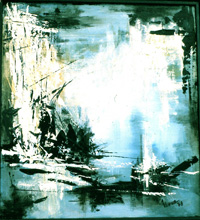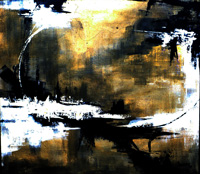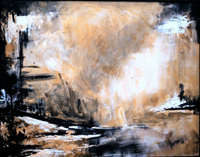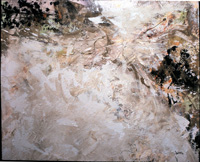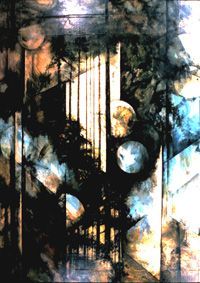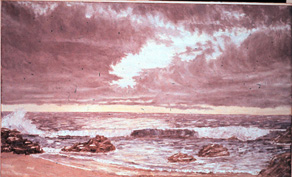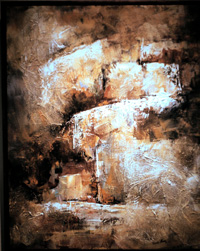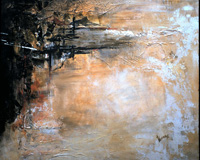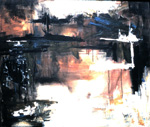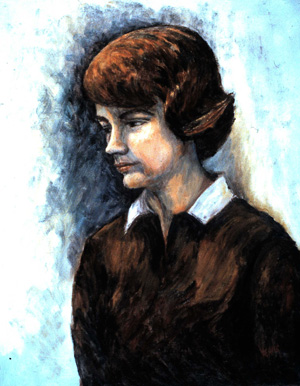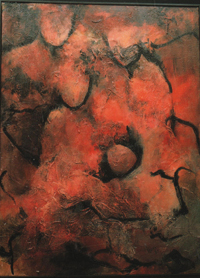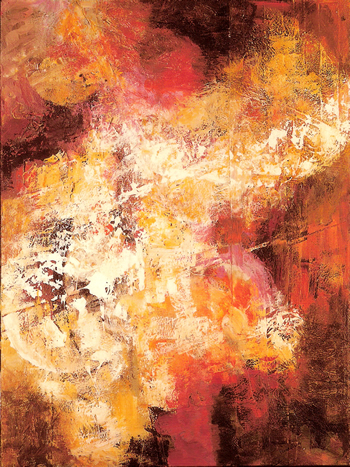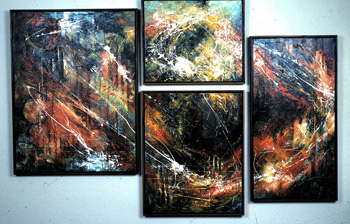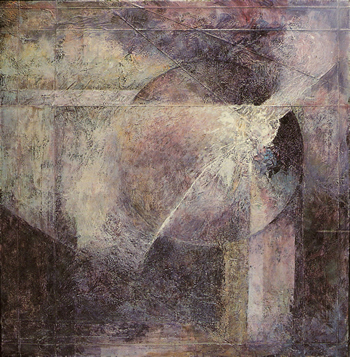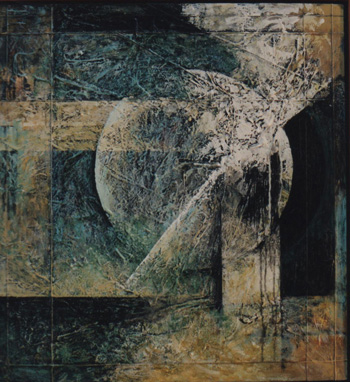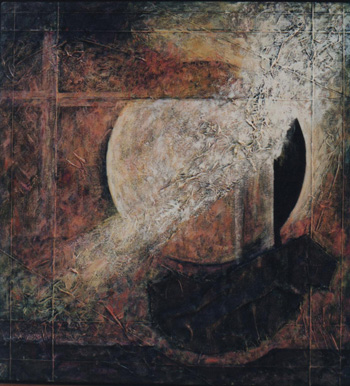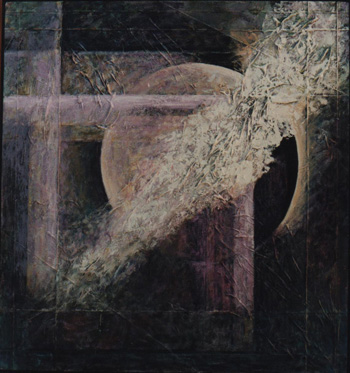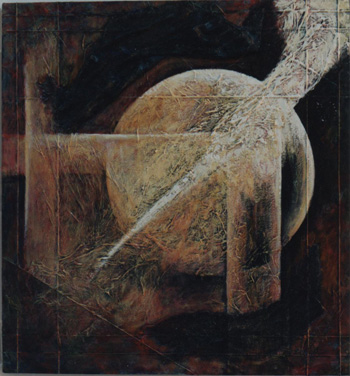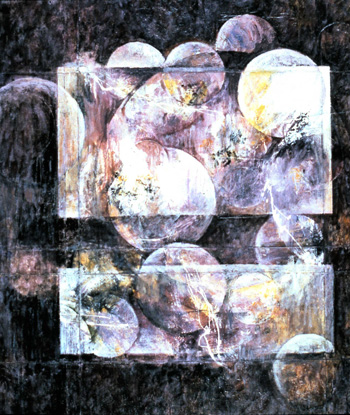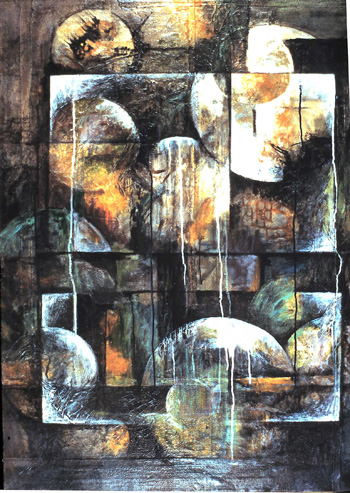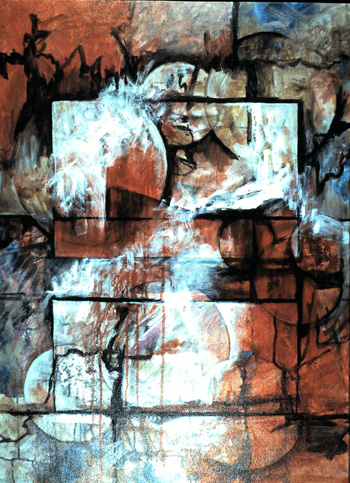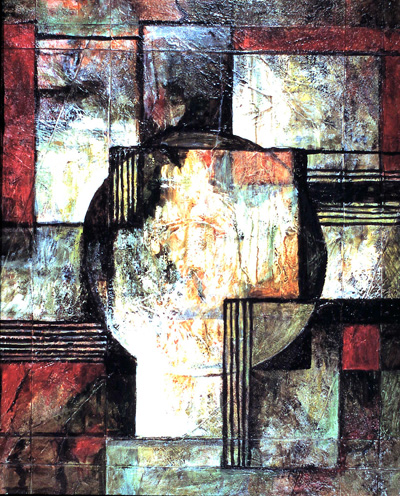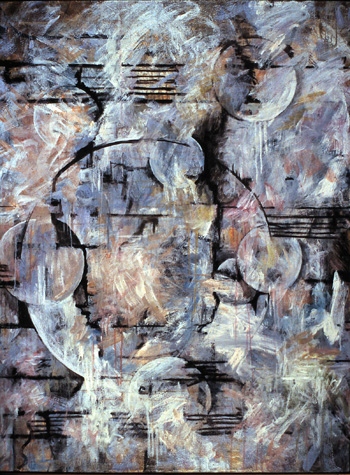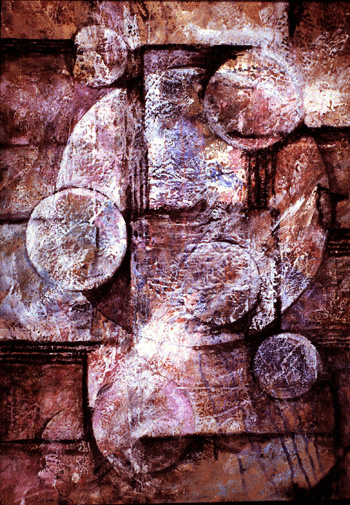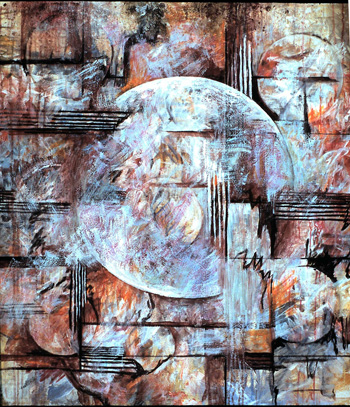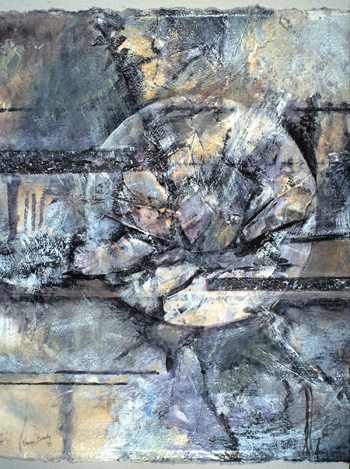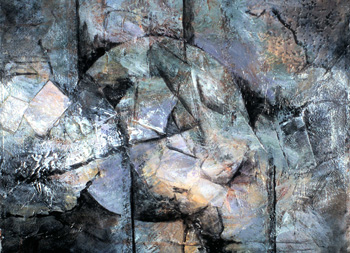Hear tapes of adult lectures Here.
Verna's Talk for Children
Good morning (afternoon), everyone. I'm here today to talk to you about abstract art, to help you understand WHY artists paint that way--and maybe even make YOU want to paint that way!
But first, let me ask you a question--
By a show of hands--how many like music?
Does it make you happy? (voice response) Can anyone tell me WHY? Anyone else?
Now let me ask you another question--how do OTHER sounds you hear all the time make you feel? Traffic sounds, sirens, dogs barking, people fighting--do they make you happy?
Does anybody have any idea WHY the sounds of music make you happy--you LIKE- THEM--but other sounds make you unhappy--and you don't like them? Anyone else?
Well, one big difference between music and noise is that music is ABSTRACT sound put together with HARMONY and RHYTHM in such a way that it moves you way down deep inside--in your SOUL! Music uses one of God's gifts--your EARS--to touch your Soul and give you joy.
Do you think it would be nice to use ANOTHER of God's gifts--your EYES--to make you happy like music does--way down deep inside you? Happy, happy in your SOUL?
You all know about Outer Space, don't you? It starts with the air around us and keeps on going way out to where the stars and planets are and even beyond--seems to have no end to it.
But there's another kind of space I'd like you to think about--Inner Space. What do I mean when I say "Inner Space?" Well, to me it is that place deep inside us where we think, where we feel and where we wonder. It's not in your arms and legs or even your body--MAYBE it's in your head or brain or heart. But MOSTLY it seems very deep, mysterious space--all your own--somewhere deep inside you that you don't really understand. The DEEPEST part is called the Soul.
Abstract artists try to reach that place in hopes of understanding it but when they do, they don't really find answers to their wonderings but somehow they DO find JOY and they want to share it with others.
To do this, abstract artists use their paint and canvas or paper to try to create a DIFFERENT kind of space. You know about perspective and shading, don't you?--the way things get smaller and grayer as they move back in space. This is what realistic artists use, but it goes only from where you are to the nearest mountain or horizon. Overlapping colors or shapes can express the deep space from here to the planets and beyond--or from here to deep inside us--our Inner Space.
To do this, I will use my painting, "The Four Elements."
Why do you suppose I call it the "Four Elements?" Well, an element is something basic needed to do or have something else. Like letters--you need to know the alphabet to be able to write words, don't you? Or notes--you can't write music if you don't know what a note is. And space scientists looking for life on other planets look for water, first of all, and then atmosphere, or air--without these two elements Life can't exist.
So MY four elements are: water, air (space), earth (a planet) and fire--to support our lives, keep us warm and allow us to cook our food so we don't have to eat everything raw.
Now let me show you how I created Space in the Four Elements with what abstract artists call push/pull.
PUSH/PULL
Let's start with the orange sweep across the center of the canvas (see image below). It seems pretty much plopped right there on the surface--on top of everything else, doesn't it? Yet if you look right here [see below] (1.) and here (2) and here (3) and especially here (4) you find the orange is being overlapped and pushed back by the whites and grays flowing down and across. Because one color is overlapping another color, your eyes can tell that the top color is above the second one and so it seems to pull forward toward you and push the other one back away from you. This gives you a sense of Space between the two colors and on the canvas or paper. This is called Push/Pull. Can you feel that space between the two colors?
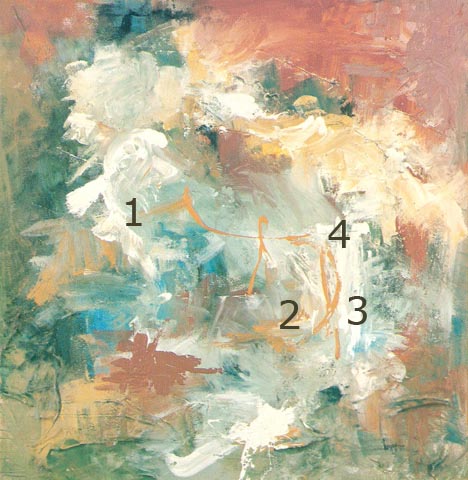
Now if we take this white (1) which is overlapping the orange and follow it down the work, we find it being pushed back by this blue (5). Thus the blue comes forward, the white is pushed back and the orange goes even farther back.
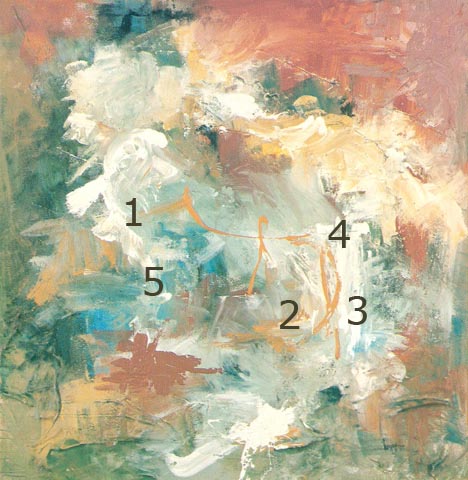
But now let's move to this deep red-orange (lower left). See how it overlaps the blue, and pushes all three colors back--the blue, the white and the orange. Can you see this? (6 below)
Now look here (upper left--7), see how first the white, then the orange are pushing back another blue-gray which in turn is pushing the grayed-orange back, which is pushing the deeper red-orange back, and , finally this tiny dark is being pushed back farthest of all.
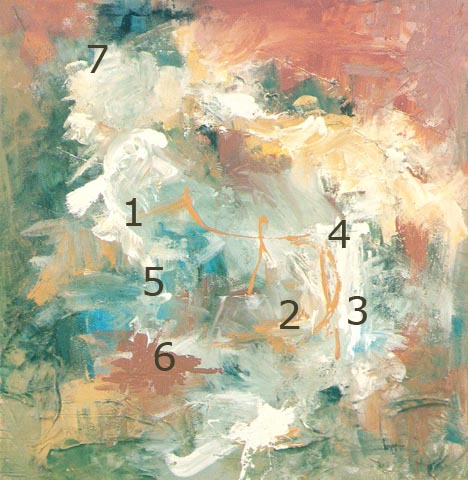
So we have a 1.(red-orange), 2. (blue), 3. (white), 4. (orange), 5. (blue-gray), 6. (gray-orange), 7. (gray-red), 8. (dark) step push/pull back and forth in space creating a sense of depth, movement and aliveness. (demonstrate) Do you understand that this creates space on a canvas?
[Here she would show another slide and have someone explain and demonstrate space in that work.]
RHYTHM
Now let's think about rhythm. Rhythm is something important in music, isn't it? It's important in Art, too. It creates movement around and through the painting by what is called color intervals...using the same color to pull your eye from place to place. And as your eyes move from color to color, you sense movement, rhythm and space. For example: (demonstrate using the Four Elements--ed. note--using Hoffman's The Pond here as we have the color interval slides she used in the adult talk for this demo. I have so far not found the slides she used here with the Four Elements).

DYNAMIC EQUILIBRIUM
Another important idea that abstract artists use is called Dynamic Equilibrium. What do you suppose Dynamic Equilibrium means? Well, dynamic means movement and equilibrium means "in balance." So dynamic equilibrium means "movement in balance." How does that apply to a painting?
Well, it means that a painting must be kept in balance, that for every push, there must be a corresponding pull. An easy way to explain this is with a blown up balloon. If you push your finger on one side, what happens? The other side bulges out, doesn't it? The push with your finger created a tension and it was balanced by the bulge on the other side. This is Dynamic Equilibrium.
It's the same in a painting. If you create a big push somewhere, you have to create balance with a pull somewhere else.
For example, notice how the small, strong red-orange in the lower left pulls on the large area in the upper right--and balances it. Notice what a difference removing it makes+--the painting seems off balance. Put it back and the pull creates balance again.+ Can you feel this?
Now see how the tiny dark in the lower right holds the darks in the upper left in balance. Remove it+ and it affects the balance. Put it back+ and the balance is once again restored.
Remove both +- two very tiny areas compared to the whole painting--and look what a difference it makes. The work seems top-heavy, very out of balance and somehow lacking in liveliness. Put both back+ and liveliness and balance return.
[Verna had slides separating the colors in this painting. The + signs were where she was switching between these slides. I have not been able to find these slides, but will add them if I ever do!]
[Here she would show another painting, then have someone summarize and show the Dynamic Equilibrium.]
ABSTRACT/REALISM
What I have been telling you about are the principles of visual composition which give me the means to explore and express thoughts and feelings about the "world without" and, especially, the "world within" on a much deeper level than I could with "pure" realism--with just trying to make my painting look like what I am looking at--a landscape, a person, still life...whatever. (demonstrate with sequences)
Where once I did a still life like this+
Where I once painted people as realistically as I could,
now I could paint my feelings of the warmth and love of a family group and let you, the viewer, fill in the details. Most importantly, it says "family" and the love they feel for each other.
SYMBOLS
But suppose I wanted to express OTHER ideas--maybe things I think about or wonder about--how would I do it? Well, one way is to use symbols. Do you know what I mean by symbols? I bet you know what icons on computers are, don't you? Symbols are kind of like that--icons stand for something else. Symbols are shapes or forms used to explain or represent something else, too--especially an idea. Like notes on paper represent musical sounds.
Let me bring back the Four Elements...did you notice earlier, how the movement is circular? +
Many others done in this period also have a circular movement.++
+Circe is the first work in which the circle itself becomes clearly identified as a compositional element--yet the circle emerged from my subconscious and was not consciously noticed until the work was done.
+I respond to music, too, like you do--and especially symphonies. Do you know what classical symphonies are? They are works in music in which the composer relates four or more separate musical compositions to each other--primarily by repeating a theme melody in each of the pieces. Some years ago I wanted to PAINT some symphonies. In these, the circular movement of the various rhythms ties all the movements together--as does repeating the same melody or variations of it in a musical symphony.
+In Beethoven's Ninth the circle erupted strongly from my subconscious as the structure needed to complete the work. I had already introduced the line as one element different in the Fourth Movement from the other three (demonstrate). But I felt I needed something more. After much experimentation, the circle finally came through as the answer. (explain Ode to Joy, daughters of Ellysium, skies above--ed. note: do not know what this was).
From then on, the circle and line became powerful tools I could use to express other abstract ideas as well. Let me show you some of my works:
THE FIFTEENTH STATION
+The circle and line emerged as compositional elements (points out) in the Fifteenth Station. The circle became a symbol for Being (a person), the lines formed a Cross and the strong light in the upper right symbolized God. This particular structuring led to my ability to expresss my innermost feelings about a very difficult time in my life--my heart problems leading to two open-heart surgeries and my husband's aneurysm in his brain.
Psalm 23+--the Lord is my Shepherd, I shall not want--He maketh me to lie down in green pastures--he restoreth my soul--yea, though I walk through the valley of death, I will fear no evil.
Psalm 30+ I will praise you, Lord, you have rescued me...O Lord, I cried to you for help and you, my God, have healed me. O Lord, you have raised my soul from the dead.
Psalm 116+ My husband had been diagnosed as having an inoperablee aneurysm in his brain! The only hope was placing a "balloon embolism" in the aneurysm. Psalm 116 was in the readings on the Sunday he was in intensive care following the procedure. As I listened and followed along, an inner voice substitued "he" and "him" for "me" and "my" and "we" for "I". A wave of strong emotion swept over me and tears welled up in my eyes. In that instant I knew deep within me that God had once again answered my prayers. They surrounded (him) the snares of death, they caught me, sorrow and distress. I called on the Lord's name. O Lord, my God, deliver (him). I was helpless and so he saved (him).
Psalm 151+ In the midst of my heart problems, I really wanted and needed to thank God for His help and so I decided to try to express my gratitude to Him with my own "new song unto the Lord." Before the painting was completed, however, a second by-pass proved necessary and was sucessful. So often I have cried out to the Lord to keep me from the grave. Each time He has heard my pleas and answered. Each time He has turned back the dark cloak of death and pushed away its shadow. Each day I thank the Lord for allowing me to linger yet awhile in this life I so love.
THE WINDOW SERIES
+This is one of my window series.
Because of a need to try to understand the many mysteries of Life, I try to allow my canvas to function as a window through which the mysteries of the Universe Without and the Universe Within may pass, mingle and become one. +
This is expressed by having the circles flow in and out on the linear structuring of the "windows."
EPIPHANY SERIES
+This painting is called Epiphany.
It is another expression of both my spirituality and my probing of my subconscious. Somehow while I was painting this work, I felt a need to add a large central circle to pull the composition together. In thinking about why this seemed right, I experienced an epiphany--a sudden realization that the central circle could be another symbol for God.
In others of the series, the small circles could symbolize our relationship to Him--some are very close, some are far away.
I have not yet figured out the meaning of the multiple lines, but, somehow, they seem necessary.
MANDALA SERIES
All the paintings I have shown you so far are on canvas. The Mandala Series is on paper. I've brought a couple for you to see because that is what you will be working on--paper.
In these a central circle once again emerged and the colors tend toward a quiet, spiritual purple.
I chose to name them Mandalas because mandalas are circular symbols of the Universe and its powers used for meditation and/or ritual in both American Indian and Eastern religions. I have always responded to mandalas. They seem to touch that deep Space Within me and make me happy.
TRINITY
This is a painting I just finished. It seems to come back a bit toward a recognizable image, doesn't it?--a waterfall flowing over rocks--but did you ever see PURPLE rocks? But you know what--there's a lot more to it than that.
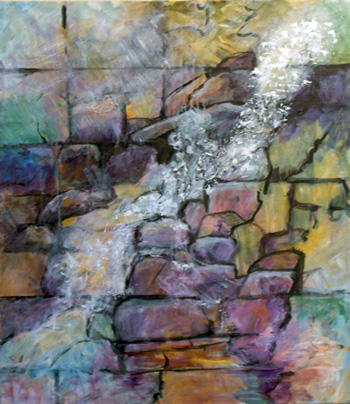
What do you suppose all this means? Anyone have an idea?
Remember how I mentioned before when I talked about the Fifteenth Station and the Psalms that a strong, powerful light (white) in the upper right has become one of my symbols for God? Well, the waterfall is coming from that light and flowing over the world--the rocks--and giving them a spiritual glow--purple is a spiritual color as I mentioned before and up in the left corner there are three faint crosses. The one most visible and largest seems to be touching the second one--the third seems quite distant from the other two. So my symbol for God is there in the upper right and the Holy Spirit (the waterfall) flows from Him and influences all things...and the touching crosses are about Jesus' promise to the criminal who asked to be remembered and the distant one is the one who rejected Him.
Well, I've been telling you a lot of things and showing you a lot of paintings. Does anyone have any questions about all of this?
So do you think that now maybe it's time for YOU to make an abstract painting? Would you like to try?
While I am getting things ready, you may come up and look at the paintings if you'd like. I'll be making set-ups like I used when I was learning to make anstract works--abstract still lifes. No bottles, vases, flowers or such. This will force you to use your right brain--the starting place for your trip to the Inner You. Objects would make your left brain try to copy them (remember left brain, logic) and you'd never get past that--you'd wind up with a still life of flowers or vase or whatever.
Ok, we're ready. (I'm going to do a brief demo on how I go about this.)
When I start painting, I do exactly what I am going to ask YOU to do. I look at all my colors and decide what colors I LIKE that day--colors have moods just like we do--yellows, reds and oranges are mostly happy colors. Yellows always seem happy but some reds and oranges can be angry colors. Blues, greens and purples are restful and quiet although there are blues and greens that are harsh. The right kind of purple is spiritual but some are very harsh and so on. So, I pick a color to match my mood and begin there. Then I add other colors that seem "right" with those first colors.
As I work, I turn the painting by quarter turns--partly to correct the composition, partly to tickle my Spirit awake. I don't decide which side is up until very far into the painting process--until it's almost done.
[Examples of painting in process with turns.]





As I go deeper into my Inner Space sometimes forms or lines appear. If I like them, I keep them. If I don't, I paint over them. Lines have moods, too. Sharp, jagged lines---anger or nervousness--earthy, also calm Upright lines--spiritual.
Now I've shifted my conscious mind into neutral--and just like a car, it doesn't GO anywhere in neutral. So, it can't tell me how to paint the painting. I'd probably say "it's a mess--paint over all of it." Gradually the Inner Me tells me what to do and will tell me when it's done. And THAT'S when I try to figure out what the MEANING of the painting is. I didn't start out deciding what I was going to paint. THAT would have been Left-brain painting (remember left and logic both begin with an L.) I want to be SURPRISED by what happens--it's MUCH more fun!
So now it is your turn. Look at the set up like I did and then pick the colors you want to use. Have FUN with color like you used to when you were a little kid--remember?--Playing with crayons and paint. But NOW you know so much more. Now you can REALLY have fun and make space, rhythm and movement with your colors. Just let yourself respond to the neat colors and movement you are creating and soon you'll be in that deep Inner Space--and IT will tell you what's right and what to do next. And the painting will be an expression of your happy, happy SOUL!!
I'll come around to help you and make suggestions.
Verna Brady
[This lecture was edited from Verna's lecture notes and slides by Caryn Brady, Verna's daughter. All materials on this site are subject to copyright. Please contact us for permission to use any of these materials.]
